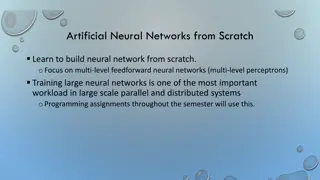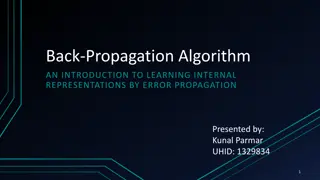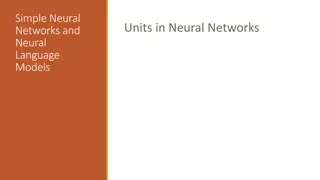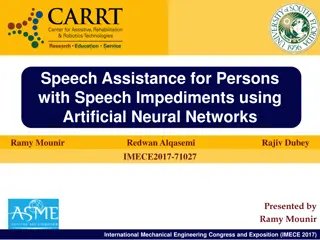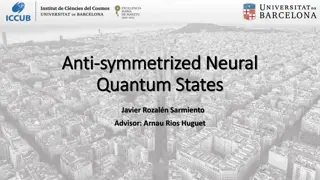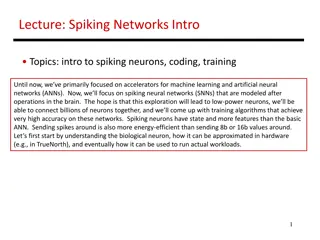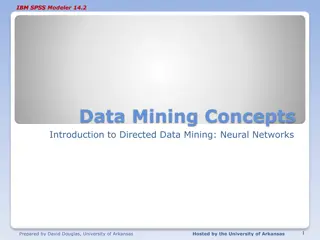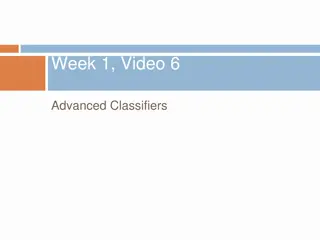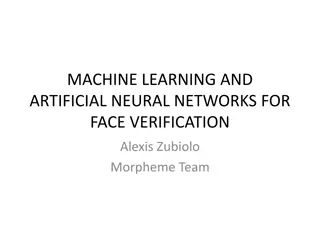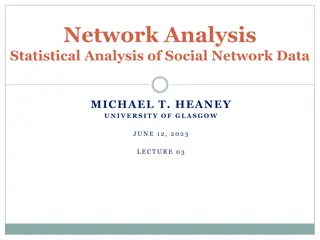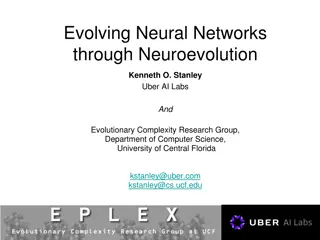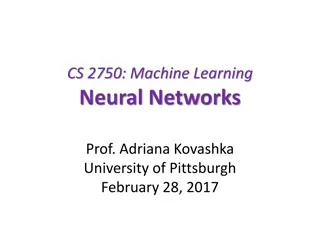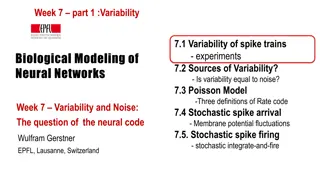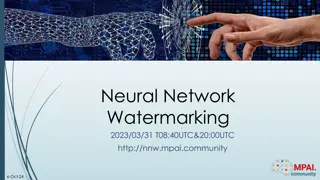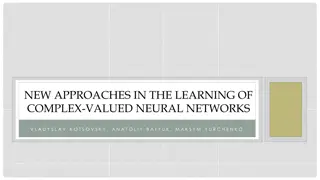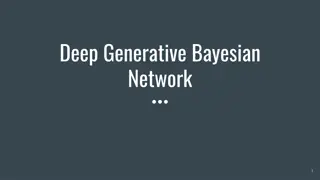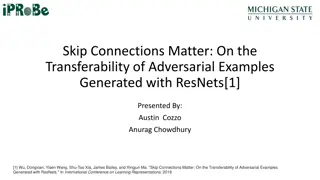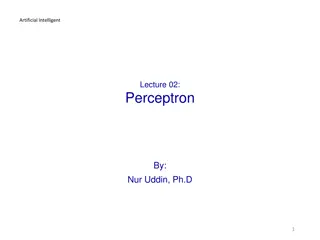
Introduction to Neuroevolution and Neural Networks
"Neuroevolution involves evolutionary algorithms to tune neural network parameters, while neural networks have evolved from perceptrons to multi-layer perceptrons. This overview covers neuroevolution techniques, comparison with deep learning, and historical background."
Download Presentation

Please find below an Image/Link to download the presentation.
The content on the website is provided AS IS for your information and personal use only. It may not be sold, licensed, or shared on other websites without obtaining consent from the author. If you encounter any issues during the download, it is possible that the publisher has removed the file from their server.
You are allowed to download the files provided on this website for personal or commercial use, subject to the condition that they are used lawfully. All files are the property of their respective owners.
The content on the website is provided AS IS for your information and personal use only. It may not be sold, licensed, or shared on other websites without obtaining consent from the author.
E N D
Presentation Transcript
INTRODUCTION TO NEUROEVOLUTION Deacon Seals
DISCLAIMER You could make an entire course over neuroevolution This is not my direct area of expertise There are multiple generations of research on neuroevolution There are many tangential research areas that relate to and sometimes intermingle with neuroevolution 2
DISCLAIMER Neural networks can be somewhat divisive in the EC community Success of deep learning has led to an us vs them mentality This seems especially prevalent in the old guard of EC Though there are notable exceptions Due to the success of deep learning, neuroevolution appears to be booming in the EC community Many great examples of up-and-coming researchers Hybridizing deep learning and EC Discovering new areas where EC can offer novel contributions 3
What is Neuroevolution? The application of evolutionary algorithms to tune the numerical parameters within a neural network Some of these techniques also involve autonomous design of the network topology Many of these algorithms originated for generic numerical optimization tasks Architecture search algorithms may explore topology space and leave network tuning to other algorithms E.g., training with deep learning This is distinct from neuroevolution as far as I m aware 4
Overview A Brief Intro to Neural Networks Neuroevolution Comparison with Deep Learning Simple GA/ES CMA-ES NEAT Quality Diversity MAP-Elites 5
A BRIEF INTRO TO NEURAL NETWORKS Non-exhaustive!!
Brief History Perceptron ? ? = ? ? ? + ? A.K.A. McCulloch-Pitts neuron 1943 Hand-tuned weights implemented by circuit Linear classifier 1969 - can t represent XOR Solution: layers of perceptrons (which already existed) This Photo by Unknown Author is licensed under CC BY-SA 7 This Photo by Unknown Author is licensed under CC BY-SA-NC
Brief History Multi-layer Perceptron (MLP) A.K.A. Dense Neural Network 1958 - Frank Rosenblatt Also introduced learnable weights and threshold Eventually incorporated nonlinear activation functions 1986 Rumelhart, Hinton, Williams Modern gradient-based tuning Use chain rule to backpropagate though nonlinear activation functions This Photo by Unknown Author is licensed under CC BY This Photo by Unknown Author is licensed under CC BY-SA 8
Brief History Recurrent Neural Network (RNN) Provides memory to networks Starts with a state of all zeros Outputs new state which is fed back in 1997 Long short-term memory (LSTM) Hochreiter and Schmidhuber Not the first, but the most famous This Photo by Unknown Author is licensed under CC BY-SA 9
Brief History Convolutional Neural Network (CNN) Slides a filter of weights about a 2D input Generates a subsampled 2D output (i.e., smaller 2D output unless filter is 1x1) Multiple filters may be used and the 2D output of each are stacked to a 3D output Outputs typically flattened to 1 dimension and passes through dense layer Popularized by LeNet 1995 LeCun et al. This Photo by Unknown Author is licensed under CC BY 10
Deep Learning TL;DR Neural networks are basically complicated parameterized linear algebra expressions Matrices of parameters affect behavior of the expression Say there are N parameters within all these matrices Evaluating neural network = evaluating equation = ?(?) Performing all matrix operations in equation These expressions are differentiable (in deep learning) Loss function For a given input, defines numerical difference between expected output and neural network output (e.g., error) Tuning parameters akin to traversing an N-dimensional space Each point in this space corresponds to a combination of parameter values that produces a particular loss 11
Deep Learning TL;DR Backpropagation Partial derivative of loss function w.r.t. network parameters Broken down to smaller, easier problems via chain rule Computes a gradient w.r.t. constants in neural network Like calculating the slope of a curve, but in N-dimensional space Gradient contains a value for every network parameter Basically, an N-dimensional heading/direction that causes an increase of the loss function This direction does not have a magnitude, so we multiply it by some step size Update parameters by adding or subtracting gradient Subtract for gradient descent (minimize loss/error) Add for gradient ascent (maximize loss/reward) 12
Notable Additional Events 2013 AlexNet demonstrates GPU training Drastically improved performance on image classification task afforded by efficient training Deep learning wins the hardware lottery Kickstarts current AI boom 2017 Transformer networks Uses attention mechanism to replace memory Outperforms LSTMs on most applicable tasks Benefits from gradient-based optimization more than RNNs Revolutionizes natural language processing (NLP) E.g., foundation of Chat-GPT GPT: generative pre-trained transformer 13
Fine Points Neural networks consist of numerical parameters which can be tuned Deep learning is a gradient-based tuning approach Neuroevolution is a gradient-free tuning approach Architectural advances to neural networks are directly impactful to neuroevolution The use of dense, CNN, and LSTM components Some of these advances are biased towards deep learning methods E.g., transformers make more effective use of backpropagation than LSTMs Transformers may still lend themselves to neuroevolution though 14
Comparison With Deep Learning Deep Learning Requires differentiability of all components Allows for clear indicators of search direction Requires differentiable loss or reward functions Can optimize during multi-step tasks (e.g., games) Neuroevolution Does not require differentiability Enables non-differentiable network components Spiking neural networks Allows for non-differentiable problems Meaningfully more flexible Requires many full episodes of multi-step tasks (e.g., games)
Comparison With Deep Learning Deep Learning Explicitly calculates a performance gradient Cannot tolerate discontinuities Neuroevolution Optimizes about an implicit search gradient Still stumbles with deceptive fitness landscapes E.g., discontinuities Meaningfully less sample efficient on many problems I.e., requires more fitness evaluations than deep learning Can operate on arbitrary non- binary performance metrics Uses hill-climbing-like gradient traversal algorithms Benefits from making gradient smoother Incorporates mechanisms to leave local optima
Simple GA/ES Linear genotype of floats Translated into more complex geometries based on network architecture at evaluation time Mutation only variation operators Gaussian noise is very common Genetic Algorithm (GA) Parent selection to form a child pool Some sort of survival selection Evolutionary Strategy (ES) Most or all individuals generate a child Child directly replaces their parent if better Common in competitive coevolution 18
CMA-ES Covariance Matrix Adaptation Evolutionary Strategy Covariance matrix describes variances between dimensions in a multivariate normal distribution Does not adhere to typical EA loop Uses ask-eval-tell loop instead Does not adhere to typical EA population-based search Population is generational Children are not directly created from parents Akin to searching for a multivariate normal distribution Sampling this distribution yields good solutions 19
CMA-ES Multivariate normal distribution Mean vector ?0,?1, ,?? Covariance matrix Matrix of size ? ? Describes variance in multiple dimensions Symmetric matrix Diagonal contains variances (i.e., ?0,?1, ,??) CMA-ES updates the mean vector and covariance matrix needed to describe this distribution Dimensionality of distribution same as number of parameters in neural network Image in public domain from source
CMA-ES Ask Randomly sample solutions from multivariate normal distribution Utilizes covariance matrix and vector of per-dimension means Eval Evaluate population of solutions sampled from distribution Tell Rank solutions based on performance Calculate a weighted update to means and covariance matrix based on solution values Shift distribution towards known good solutions, away from bad 21
CMA-ES Population Size Number of times distribution is sampled each generation Smaller population -> local search Most samples near current means Larger population -> global search Greater chance of samples farther from current means Some CMA-ES variants alternate use of large and small population sizes Use global search until improvement stagnates Use local search to fine tune on current means until convergence Double population size from global search step Repeat 22
NEAT Neuroevolution of augmenting topologies 2002 Kenneth Stanley and Risto Mikkulainen GA approach Maintains a persistent population (as opposed to CMA-ES) Uses a direct encoding scheme Directly represents every neuron and connection in a neural network Lots of variations introduced by Mikkulainen, Stanley, and others 23
QUALITY DIVERSITY (Pause for questions)
QUALITY DIVERSITY In my opinion, one of the most promising areas of active research Originally based in research into artificial life (A.K.A. A life) Open ended evolution based on diversity Typically used to study environment dynamics rather than optimization 25
QUALITY DIVERSITY Optimize with respect to behavioral diversity Emphasis on direct performance is often secondary Allows for alternate definitions of success that may be further optimized Can outperform direct optimization Commonly uses neuroevolution Underlying methodology not inherently restricted to neuroevolution E.g., QD algorithms for GP are possible 26
MAP-Elites Multi-dimensional Archive of Phenotypic Elites Archive model population Define grid based on discretized behavioral features E.g., percentage of time a bipedal robot had each foot off ground Phenotype corresponds to specific archive location Save solution to archive location if empty or fitness is better Randomly select parent from archive Mutate selected parent to generate child Image from Mouret, J. B., & Clune, J. (2015). Illuminating search spaces by mapping elites. arXiv preprint arXiv:1504.04909. 27
MAP-Elites Requires careful definition of behavioral features Define structure of archive Indirectly related to performance Studies typically perform ablation with combinations of features Too many features hinders optimization performance Predicated on effective mutation operations Hallmark of neuroevolution More akin to GA than ES Children can replace population members other than parent A persistent (steady-state) population is maintained be archive 28
Recommended Tools evosax JAX-Based Evolution Strategies https://github.com/RobertTLange/ evosax QDax Accelerated Quality-Diversity https://github.com/adaptive- intelligent-robotics/QDax
CLOSING REMARKS Problems well-suited to deep learning Deep learning is typically faster and more performant No small amount of effort goes into reformatting problems to become well-suited (the results should not be dismissed though) Neuroevolution can do some things deep learning can t Optimize non-differentiable network architectures (e.g., spiking neural networks) Optimize problems with no or ill-suited loss/reward functions Neuroevolution benefits from architectural advances in neural networks (typically brought about by deep learning) 30
CLOSING REMARKS Newer variants of neuroevolution and quality diversity algorithms are adding deep learning mechanisms Some domains like NLP are gaining interest in neuroevolution to evolve novel neural network architectures Neural networks aren t necessarily the best solution to some problems E.g., discrete optimization, combinatorial optimization, certain ill- suited automated design problems (at least currently) This presentation only scratches the surface of these topics AI isn t magic 31




